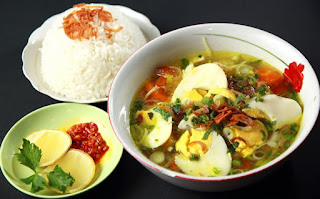Soto is a traditional Indonesian dish that is widely popular across the country. It is a type of soup that typically contains meat, vegetables, and various spices.
Two common variations of soto are soto ayam, which is made with chicken, and soto daging, which is made with beef. Both variations are loved for their rich flavors and comforting warmth, making them a favorite among Indonesians and food enthusiasts alike.
Soto ayam is a delicious and flavorful soup that is made with chicken. The dish is typically served with rice, vermicelli noodles, boiled egg, and various toppings such as fried shallots, celery, and lime. The broth of soto ayam is infused with a blend of spices such as turmeric, ginger, garlic, and lemongrass, giving it a fragrant and savory taste.
The tender pieces of chicken add a meaty texture to the soup, making it a hearty and satisfying meal.
On the other hand, soto daging is a beef version of the traditional Indonesian soup. This variation features slices of beef simmered in a rich and aromatic broth that is flavored with a mixture of spices and herbs.
Soto daging is typically served with rice, vermicelli noodles, and an assortment of toppings such as sprouts, cabbage, and lime. The combination of tender beef and fragrant broth creates a comforting and nourishing dish that is beloved by many.
Both soto ayam and soto daging are renowned for their nutritious ingredients and rich flavors.
The use of traditional Indonesian spices such as galangal, coriander, and cumin adds depth and complexity to the soups, creating a harmonious blend of savory, sweet, and spicy flavors. The addition of fresh herbs and vegetables not only enhances the taste of the soup but also contributes to its nutritional value, making it a wholesome and balanced meal option.
In addition to its delicious taste and nutritional benefits, soto is also a dish that holds cultural significance in Indonesia. It is often served during special occasions and celebrations, such as weddings, festivals, and religious ceremonies.
The preparation and serving of soto require time, skill, and attention to detail, reflecting the importance of food in Indonesian culture and tradition. The dish is often shared with family and friends, fostering a sense of community and togetherness.
As a person that love food culture and culinary arts, I am fascinated by the history and culinary techniques behind traditional dishes like soto.
The intricate blend of flavors and textures in soto ayam and soto daging is a testament to the rich culinary heritage of Indonesia.
The use of fresh, locally sourced ingredients and time-honored cooking methods highlight the country's dedication to preserving and celebrating its culinary traditions.
Furthermore, soto can also be adapted and customized to suit individual preferences and dietary needs.
Vegetarian or vegan versions of soto can be made by substituting meat with plant-based protein sources such as tofu, tempeh, or mushrooms. Gluten-free options can be created by using rice noodles or omitting wheat-based ingredients.
The versatility of soto makes it a versatile and adaptable dish that can cater to a wide range of tastes and dietary requirements.
In conclusion, soto ayam and soto daging are beloved Indonesian dishes that exemplify the country's rich culinary heritage and vibrant food culture. The aromatic spices, tender meats, and fresh vegetables in these soups create a symphony of flavors and textures that are both comforting and nourishing.
Whether enjoyed during a special celebration or savored as a comforting meal at home, soto is a dish that brings people together and pays homage to the diverse and colorful culinary traditions of Indonesia.
As a person with a passion for food and culture, I look forward to exploring more traditional dishes like soto and delving deeper into the stories and traditions that make them so special.
.jpeg)


Komentar
Posting Komentar